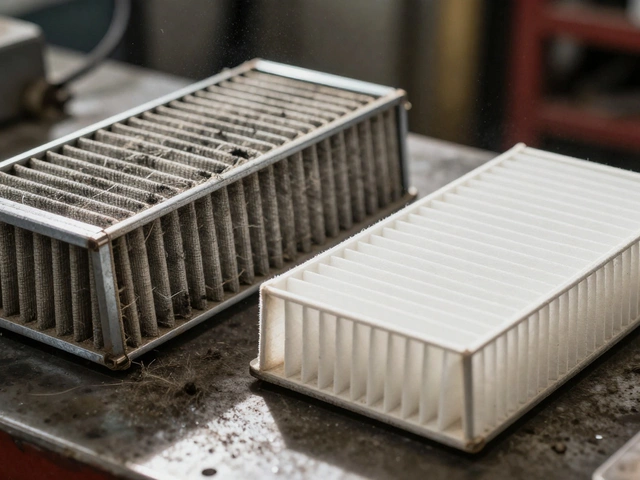Spark plugs might be small, but their role in your vehicle’s engine is unquestionably significant. They are the unsung heroes that ignite the air-fuel mixture within your engine's cylinders, sparking life into your car’s journey. A slight misstep in their function, and you might face hurdles in performance or fuel consumption.
Understanding how these tiny components work and the effect they have on your car's performance can save you time and money. Whether they're contributing to a smooth idle, ensuring optimal fuel efficiency, or reducing emissions, the right spark plugs can make a notable difference. This article delves into their workings, the variety available, and tips to keep them in top form, ensuring your vehicle hums with efficiency and reliability.
Understanding Spark Plugs
When it comes to engines, whether they're in cars or motorbikes, spark plugs are essential. These little parts ignite the air-fuel mixture in an engine's cylinder, which begins the combustion process that powers vehicles. Unlike the common perception that a spark plug merely creates a tiny spark, its functionality is far more nuanced and crucial. Each spark plug is connected to the ignition system, which supplies it with high-voltage electricity. This electricity jumps the gap at the tip of the plug, creating a spark. It's important to note that this spark must occur at just the right moment to ensure optimal engine performance. As Einstein once said, "Knowledge is realizing that the spark plug does a lot more than just make sparks; it defines the rhythm of the whole engine."
Interestingly, spark plugs not only ignite fuel but also help in dissipating heat away from the combustion chamber. This contributes to preventing issues such as pre-ignition and knocking, which can severely damage an engine over time. The spark plug achieves this by transferring a portion of the heat it absorbs from the combustion chamber into the engine's cooling system. The material and design of a spark plug influence this heat dissipation, affecting performance. For instance, copper spark plugs offer excellent conductivity and heat transfer but typically have a shorter lifespan compared to advances like iridium or platinum plugs.
Let us delve into a little of the technical characteristics of spark plugs— a typical spark plug may look simple on the surface; however, its construction is detailed and specific to its function. A common spark plug has a central electrode, which is usually made of copper but coated with nickel alloy. This central electrode is insulated by ceramic, which withstands the high temperatures and prevents electrical leakage. The outer shell, usually threaded to fit into the engine's cylinder head, serves a dual purpose of anchoring the plug and conducting heat away. The firing end has a ground electrode that helps create the spark by forming a gap with the central electrode. This gap is crucial because too wide a gap can obstruct spark formation, while one that is too narrow can disrupt power. Mechanics often adjust this gap using a spark plug gap tool to match factory-set specifications, ensuring maximum efficiency and performance.
Another vital aspect of spark plugs to consider is their heat range. This is not about the temperature of the spark plug itself but rather its ability to conduct heat from the firing tip to the engine's cooling system. A "cold" spark plug conducts heat away quickly and is suitable for high-performance or turbocharged engines. In contrast, a "hot" plug retains more heat and suits engines that operate at lower speeds or loads. Understanding these distinctions is crucial for enthusiasts or DIY mechanics when selecting the right spark plug for an engine’s specific needs. Incorrect heat range can lead to problems such as fouling or overheating, negatively impacting engine performance.
Let's consider the improvement in materials technology that has revolutionized spark plug design over the years. Modern advancements have led to the development of spark plugs that improve fuel economy, reduce emissions, and offer longer-lasting performance. For example, the use of iridium directly translates to longevity. Iridium’s high melting point and durability mean it can withstand extreme conditions and wear, resulting in less frequent need for changes. Similarly, platinum spark plugs offer different advantages, including an ability to operate efficiently at higher temperatures. This enhances efficiency, particularly beneficial for cars operating in hotter climates or conditions. Over time, these material innovations have contributed significantly to better engine performance and maintenance convenience.
Impact on Engine Performance
When it comes to the heart of your car, the engine, spark plugs play a tremendously important role. They act as the catalyst for the combustion process that keeps your vehicle in motion. A well-functioning spark plug ensures that your engine fires efficiently, maximizing power and response. Spark plugs ignite the air-fuel mixture in the engine's combustion chamber. This ignition, although brief, plays a vital part in determining how smoothly your car performs. A faulty spark plug might mean incomplete combustion, leading to wasted fuel and reduced power, essentially making your engine work harder for less output.
The impact on engine performance can be quite profound. Good spark plugs can lead to increased fuel economy since they ensure every drop of fuel is optimally burned. According to studies, a single misfiring spark plug can decrease fuel efficiency by up to 30%, a significant number when considered over time. Besides, well-maintained spark plugs contribute to lower emissions, offering a greener drive, which is particularly critical given the increasing global focus on environmental sustainability.
There are several signs that your engine performance might be affected by spark plugs. Engine misfires, rough idling, and starting issues are often traced back to the spark plugs. It's not uncommon to hear a sputtering noise when these parts start to fail, signaling that the combustion process is suffering interruptions. If your car is struggling to start or doesn't drive as smoothly as it once did, examining the spark plugs might be a good first step. According to automotive experts, most spark plugs should be replaced every 20,000 to 30,000 miles, though some high-performance plugs can last longer.
Different types of spark plugs can affect performance differently. Copper spark plugs, though commonly used, tend to wear out faster. In contrast, platinum and iridium spark plugs last longer and provide more consistent performance. These modern plugs endure higher temperatures and can withstand more wear, meaning your engine will perform reliably over a more extended period. It's worth noting that while these might be more expensive initially, the long-term benefits in performance and fuel efficiency often justify the cost.
A renowned automotive engineer once said, "The efficiency of your car hinges on the tiny but mighty spark. Accountability lies in its consistent performance." This encapsulates the essence of how vital spark plugs are to the harmony of engine operations.
In conclusion, investing in quality spark plugs, regular check-ups, and prompt replacements undoubtedly contribute to a healthier engine performance. These are the building blocks of a robust vehicle function. Recognizing the signs early and understanding your vehicle's needs ensures you enjoy the road without hiccups or hazards, optimizing both your experience and expenditure.

Types of Spark Plugs
The evolution of spark plugs over the years has seen these small components adapt and diversify, catering to various engine needs and designs. They aren't one-size-fits-all, and knowing the differences can affect how efficiently your car runs. The three most common types are copper, platinum, and iridium spark plugs. Each type offers specific benefits and caters to distinct engine requirements, impacting both performance and longevity. Given the intricate dance of combustion engines, choosing the right spark plug can influence more than just the idle of your car. It's about tailoring performance to match your specific driving experience, whether that's maximizing power, focusing on durability, or improving fuel efficiency.
Copper Spark Plugs
Copper spark plugs are often the most budget-friendly and have the best electrical conductivity. In a high-performance engine with high compression or turbocharging, they are often recommended because they can run cooler. Copper's thermal conductivity allows these plugs to operate under higher compression and hotter conditions, which ensures efficacy in situations that require a hardworking ignition system. However, copper plugs wear out faster than their more modern counterparts due to their larger electrode size. Generally speaking, they are ideal for older vehicles or those engines specifically designed for their use. Their lifespan typically ranges around 20,000 miles, which means more frequent replacements if your vehicle demands them.
Platinum Spark Plugs
Platinum spark plugs are known for their durability and can last up to 60,000 miles before replacement becomes necessary. They feature a platinum disc welded to the center electrode, which decreases the wear rate considerably. Due to their longer life span and reliability, platinum plugs are often used in new car engines with electronic distributor ignition systems. The slower erosion rate of the platinum metal means they can sustain efficiency and performance longer than copper, making them a popular choice for modern vehicles focused on engine performance and ecological balance. These plugs also tend to perform well under hotter conditions, a nod to their design focus.
Iridium Spark Plugs
If you are looking for the top-tier performer in the spark plug arena, iridium is about as good as it gets. These plugs are made with a tough electrode and often have the longest lifespan, sometimes up to 100,000 miles. Despite being more expensive, their benefit lies in less frequent maintenance and replacement. Iridium is much stronger than platinum and conducts electricity well, allowing for a better spark and improved combustion efficiency. Many vehicles coming off the production line today will have iridium spark plugs pre-installed. Their design provides the best of both worlds: performance and longevity, especially in engines where efficiency and durability are at the forefront. As one automotive expert once said, "The kind of spark plug you use is akin to writing a performance script for your engine."
"Iridium spark plugs have transformed engine reliability and power distribution with their ability to withstand extreme conditions," says automotive engineer James Turner. "It's like upgrading your car's language from Morse code to a mobile network."
Spark Plug Heat Range
Beyond the material construction, another critical factor among spark plugs is their heat range. This refers to the plug's ability to dissipate heat from the tip, crucial for avoiding pre-ignition or fouling. It's not directly about creating heat, but managing it; therefore, understanding the correct heat range for your vehicle's spark plug is as vital as the plug material itself. Cold plugs channel heat away quickly, meant for high-performance environments, while hot plugs retain heat to burn off deposits in lower-speed or less-demanding conditions.
The choices you make regarding spark plugs can often feel as significant as choices in dietary regimens or work ethics. The benefits to vehicle longevity and daily reliability are tied to how well you understand and choose spark plugs suited to your driving needs and engine design. So, remember, while choosing spark plugs might seem like a routine task, its ripple effects reach deep into the efficacy of your engine, making it a decision worth thoughtful consideration.
Maintenance Tips
Keeping your spark plugs in mint condition is crucial for ensuring that your engine runs smoothly and efficiently. Regular inspections and replacements can lead to a noticeable improvement in performance and fuel economy. Typically, it's recommended to check spark plugs every 30,000 miles, but newer models with advanced materials like platinum or iridium might last longer. Always follow the manufacturer's recommendations, as these are based on extensive research and testing. During maintenance, inspect for any signs of wear and tear, such as cracks in the ceramic insulator or a worn-out electrode. These are telltale signs that a replacement is due. Moreover, carbon buildup or oil fouling can indicate other underlying engine issues that need attention.
The process of changing spark plugs is relatively straightforward and can be accomplished with a few tools. For those inclined to do it themselves, ensure that you have a ratchet set with the right size spark plug socket and a gap gauge to measure the distance between the electrode and the insulator. After carefully removing the old plug, always inspect the engine's socket for debris to ensure nothing interferes with the new plug's installation. When inserting the new spark plug, it's critical to avoid over-tightening as this can crack the plug or damage the engine's threads. Ideally, use a torque wrench to ensure the plug is fitted to the manufacturer's recommended specification.
"Regular maintenance of your vehicle is like giving it a daily vitamin. Ignoring spark plugs could lead to deeper engine troubles down the road," advises the Car Care Council, an esteemed nonprofit organization dedicated to consumer education about proper vehicle maintenance.
Keeping track of your spark plug health isn’t just about engine performance; it has a ripple effect on emissions and environmental impact. As an improperly functioning plug can lead to incomplete combustion, the result is higher emissions. Many mechanics note that a well-maintained spark plug system can reduce emissions by up to 30%, a substantial figure for eco-conscious drivers. Consider scheduling routine check-ins with your mechanic to ensure that all's well under the hood, because sometimes, minor faults are best diagnosed by a professional.
When purchasing new spark plugs, it's crucial to choose those best suited for your vehicle's make and model. The market offers various options, including single platinum, double platinum, iridium, and copper spark plugs. Each type has its benefits and intended applications. High-performance vehicles might fare better with iridium due to its durability, while older models may only require copper. Talking to a knowledgeable salesperson at your local auto parts shop can provide insight into the right choice for your ride.




